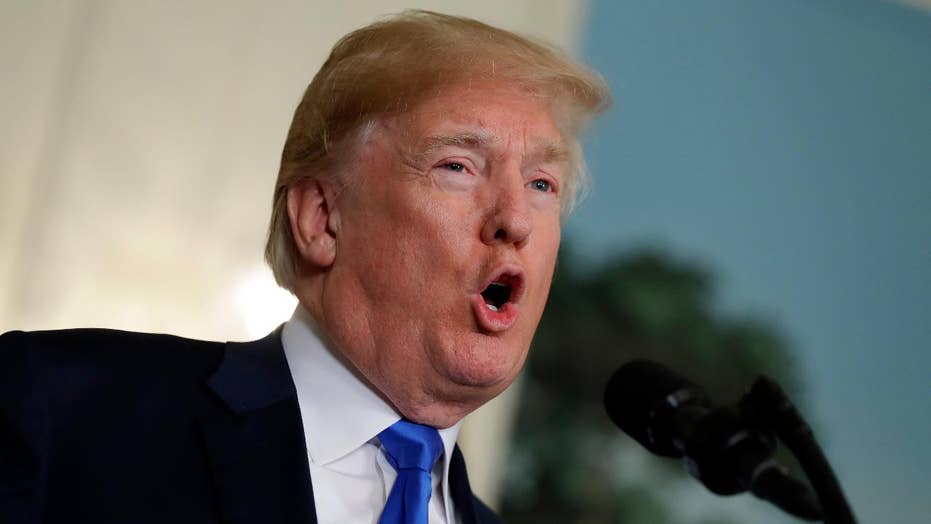Assessing The Impact Of Trump's China Tariffs On The US Economy

Table of Contents
Impact on US Consumers
Increased Prices for Goods
Trump's China tariffs directly led to increased prices for a wide range of consumer goods imported from China. This surge in prices stemmed from the added tariff costs, which were often passed on to consumers.
- Examples: Electronics (smartphones, laptops), furniture, clothing, and toys experienced notable price increases.
- Statistical Data: While precise, universally agreed-upon figures are debated, studies suggest a measurable increase in the Consumer Price Index (CPI) linked to the tariffs.
- Impact on Consumer Purchasing Power: Higher prices reduced consumer purchasing power, forcing many to adjust their spending habits or forgo purchases altogether. This led to decreased demand for some goods and a shift towards cheaper alternatives, potentially impacting both domestic and international markets. The overall impact contributed to inflationary pressures.
Reduced Consumer Confidence
The rising prices and economic uncertainty associated with Trump's China tariffs negatively impacted consumer confidence. This uncertainty, fueled by trade tensions and the threat of further tariff increases, led consumers to become more cautious about spending.
- Economic Indicators: Consumer sentiment indices, such as the University of Michigan Consumer Sentiment Index, showed a decline during periods of heightened tariff implementation.
- Decreased Spending: Reduced consumer confidence translated into decreased spending, triggering a ripple effect across various sectors of the economy, ultimately contributing to slower economic growth. This slowdown directly affected businesses reliant on consumer spending.
Impact on US Businesses
Increased Input Costs for Businesses
Many US businesses rely on imported goods from China as raw materials or intermediate goods in their production processes. Trump's China tariffs significantly increased the input costs for these businesses.
- Affected Industries: Manufacturers, particularly those in sectors like textiles, electronics, and furniture, experienced the most substantial increase in input costs. Agriculture, reliant on imported machinery and components, also faced challenges.
- Impact on Profit Margins and Competitiveness: Higher input costs squeezed profit margins, reducing the competitiveness of US businesses both domestically and internationally. Many companies found themselves struggling to maintain profitability. Some resorted to absorbing the cost increase, while others passed it along to consumers in the form of higher prices.
Retaliatory Tariffs and Export Challenges
China responded to Trump's tariffs with retaliatory tariffs on US exports. This move significantly hampered the ability of American businesses to export their goods to the Chinese market.
- Affected Industries: American agricultural products (soybeans, pork), and technology companies were particularly hard hit by Chinese retaliatory tariffs.
- Impact on Export Volumes and Profitability: These retaliatory tariffs led to reduced export volumes and lower profitability for affected US businesses. Some companies faced substantial losses and job cuts, while others sought alternative export markets. The long-term effect threatened US competitiveness in global markets.
Impact on US Employment and Wages
Job Creation vs. Job Losses
The impact of Trump's China tariffs on US employment is a complex and debated issue. While some argue that the tariffs led to job creation in certain domestic industries, others contend that job losses in export-oriented sectors outweighed any gains.
- Statistical Data: Analyzing job creation and loss data across various sectors requires careful consideration of multiple factors and is subject to differing interpretations. While some sectors might have witnessed a limited increase in employment due to increased domestic production, this rarely compensated for job losses in export sectors.
- Impact on Specific Demographic Groups: The effects of job creation and loss varied across different demographic groups, with some communities disproportionately impacted by the job losses in export-oriented industries.
Wage Stagnation or Increase?
The impact of Trump's China tariffs on wages is also a matter of debate. While some sectors might have experienced slight wage increases due to increased labor demand, the overall effect on wage growth was likely minimal, potentially even leading to stagnation in some cases due to increased production costs.
- Statistical Data: Comparing wage growth before and after the implementation of tariffs is challenging given the influence of other economic factors. Available data offers no conclusive evidence of significant overall wage increases resulting directly from the tariffs.
- Correlation and Causation: It's crucial to differentiate between correlation and causation. While increased labor demand in some sectors might have led to higher wages, it’s difficult to directly attribute this to the tariffs without considering other contributing economic factors.
Long-Term Economic Consequences of Trump's China Tariffs
Impact on Global Trade Relations
Trump's China tariffs had a broader impact on global trade relations, exacerbating trade tensions and potentially contributing to a more protectionist global trade environment. This negatively impacted international cooperation and the establishment of mutually beneficial trade agreements.
- Effects on International Trade Agreements: The tariffs strained existing trade agreements and hindered the progress of new ones. This trend promoted a retreat from global trade liberalization and increased uncertainty in the global trading system.
- Impact on Global Supply Chains: The tariffs disrupted global supply chains, forcing businesses to reconsider their sourcing strategies and leading to higher costs and delays.
Impact on US Economic Growth
The long-term impact of Trump's China tariffs on US economic growth remains a subject of ongoing discussion and analysis. While some argue that the tariffs stimulated domestic production, others point to their contribution to reduced overall economic growth due to reduced consumer spending, increased costs, and trade conflicts.
- GDP Growth Rates: Analyzing GDP growth rates before and after the implementation of tariffs reveals a complex picture, with several other economic factors influencing the growth numbers. Pinpointing the precise effect of the tariffs alone is extremely difficult.
- Lessons Learned and Future Implications: The experience with Trump's China tariffs offers valuable lessons about the complexities of trade policy and the potential unintended consequences of protectionist measures. This necessitates a more nuanced approach to trade negotiations that prioritizes long-term economic stability and international cooperation.
Conclusion
Assessing the overall impact of Trump's China tariffs on the US economy is a complex undertaking, with both positive and negative consequences affecting different sectors and demographics. While some argue that the tariffs stimulated domestic production and potentially created jobs in specific sectors, they also increased prices for consumers, hurt businesses involved in trade, and strained global trade relationships. The long-term economic consequences are still unfolding, but the experience highlights the importance of carefully weighing the potential benefits and drawbacks of protectionist policies before implementation. Further research into the specific effects on various industries and consumer groups is crucial to understanding the full scope of Trump's China tariffs' legacy. Continue your own investigation into the effects of Trump's China tariffs and their lasting impact on the US and global economies. You can find further information and resources through reputable economic research organizations and academic publications.

Featured Posts
-
 Parole Hearing Approaches For Ohio Doctor Convicted Of Wifes Murder
Apr 29, 2025
Parole Hearing Approaches For Ohio Doctor Convicted Of Wifes Murder
Apr 29, 2025 -
 Videos Show Raid Of Underground Nightclub Over 100 Immigrants Detained
Apr 29, 2025
Videos Show Raid Of Underground Nightclub Over 100 Immigrants Detained
Apr 29, 2025 -
 April 27 2025 Nyt Spelling Bee Complete Solutions And Pangram
Apr 29, 2025
April 27 2025 Nyt Spelling Bee Complete Solutions And Pangram
Apr 29, 2025 -
 You Tubes Growing Popularity Among Older Viewers
Apr 29, 2025
You Tubes Growing Popularity Among Older Viewers
Apr 29, 2025 -
 Arne Slots Liverpool A Near Miss Premier League Challenge
Apr 29, 2025
Arne Slots Liverpool A Near Miss Premier League Challenge
Apr 29, 2025
Latest Posts
-
 Nine Possible Successors Examining The Future Of The Papacy After Pope Francis
May 12, 2025
Nine Possible Successors Examining The Future Of The Papacy After Pope Francis
May 12, 2025 -
 The Papal Conclave Exploring Potential Candidates To Replace Pope Francis
May 12, 2025
The Papal Conclave Exploring Potential Candidates To Replace Pope Francis
May 12, 2025 -
 Who Could Be The Next Pope Leading Contenders And Outsiders
May 12, 2025
Who Could Be The Next Pope Leading Contenders And Outsiders
May 12, 2025 -
 Possible Candidates To Succeed Pope Francis A Comprehensive Look
May 12, 2025
Possible Candidates To Succeed Pope Francis A Comprehensive Look
May 12, 2025 -
 Next Pope Analyzing Potential Candidates For The Papacy
May 12, 2025
Next Pope Analyzing Potential Candidates For The Papacy
May 12, 2025
